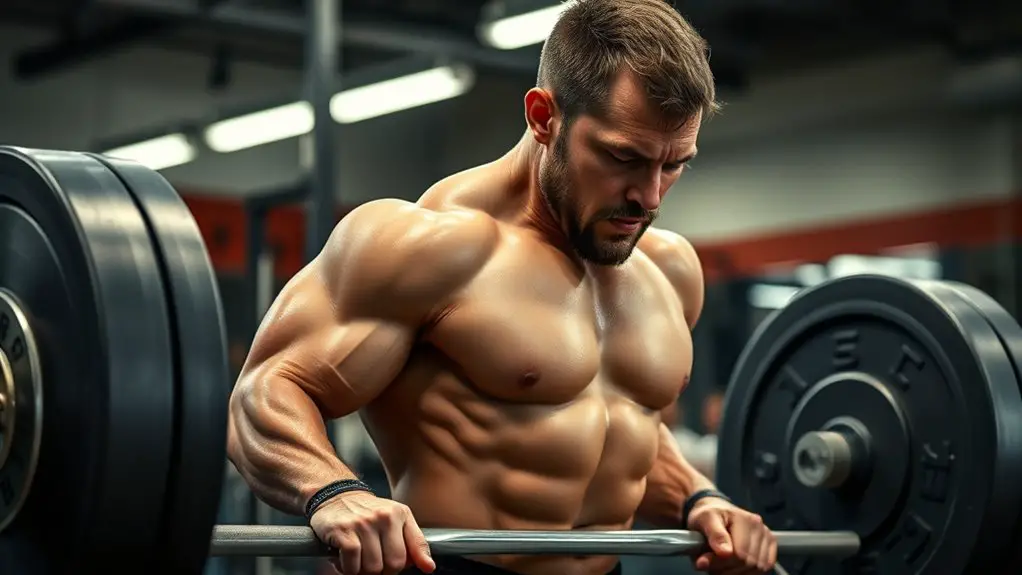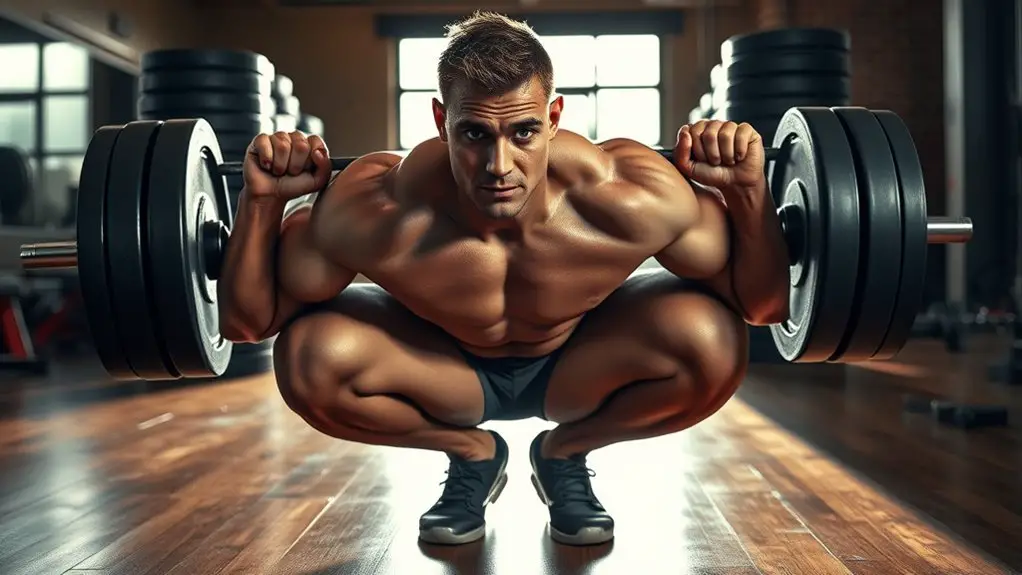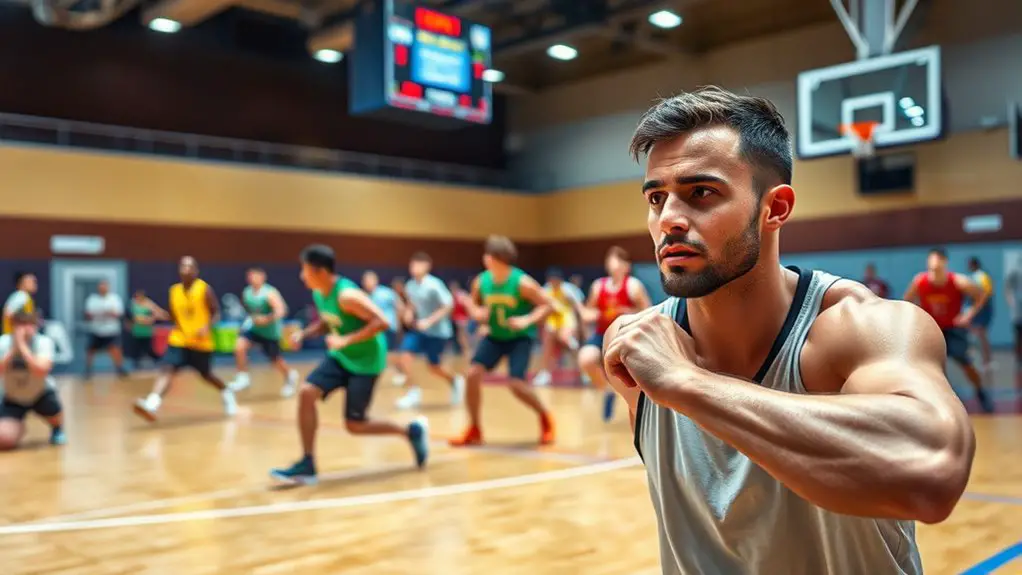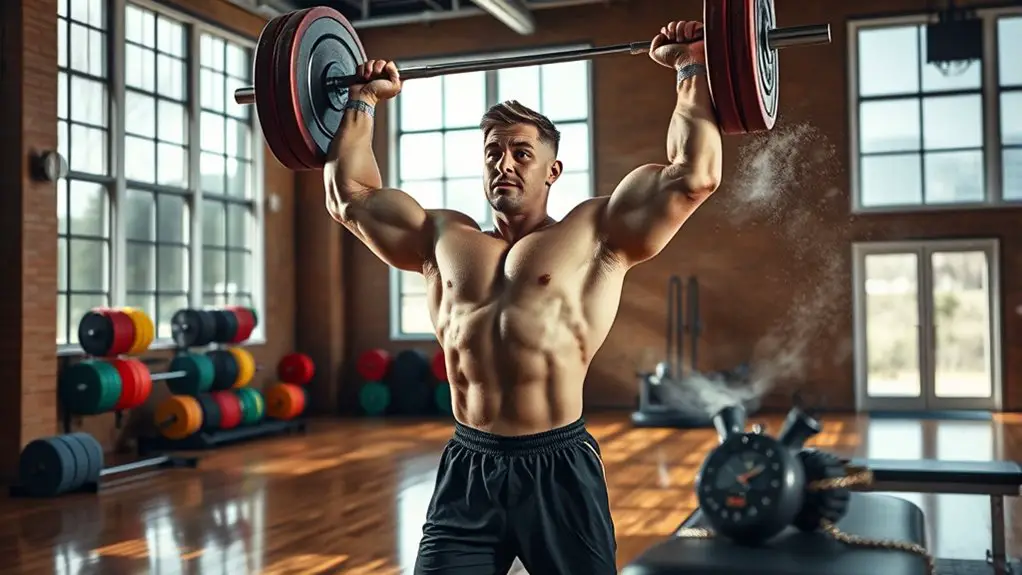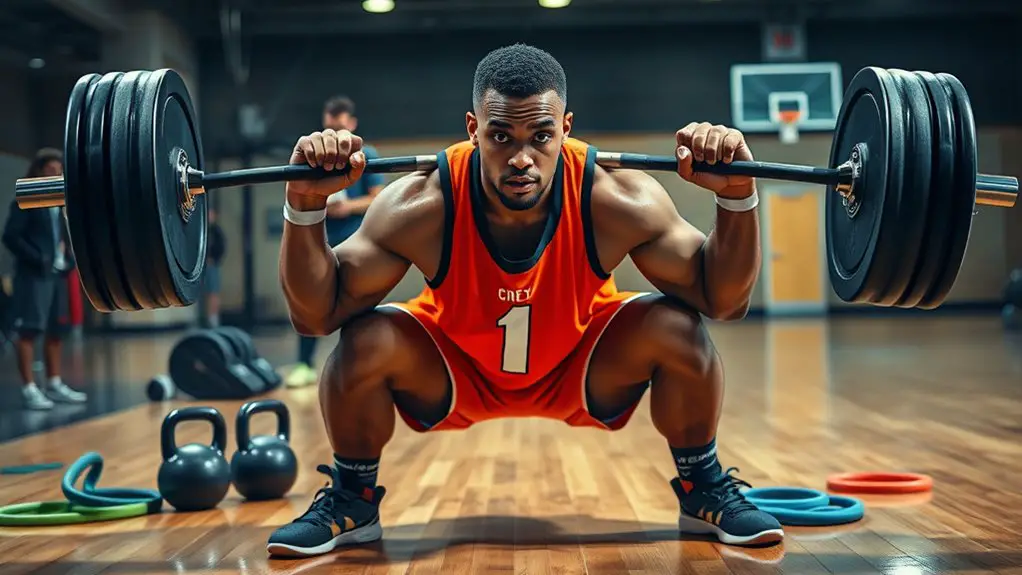To improve your posterior chain strength for powerlifting, focus on key exercises like deadlifts, hip thrusts, and rowing movements. These target your glutes, hamstrings, and lower back, enhancing your lifting performance. Don't forget to include accessory movements like Romanian deadlifts and kettlebell swings to balance muscle development. Mixing up your rep ranges is essential too, as it builds strength and endurance. Keep an eye out for common mistakes; there's plenty more to explore on optimizing your training.
Understanding the Posterior Chain
The posterior chain is an essential group of muscles that plays a significant role in powerlifting performance. This collection includes your glutes, hamstrings, lower back, and upper back. When you strengthen these muscles, you're not just enhancing your lifting potential; you're also boosting your overall athleticism and reducing injury risk.
Understanding the posterior chain means recognizing its importance in movements like deadlifts and squats. These exercises require a strong posterior chain to drive power and stability. If you want to lift heavier and achieve your liberation in weightlifting, prioritizing this muscle group is key. Incorporating deadlifts into your training routine will significantly enhance your posterior chain strength.
Embrace the journey of mastering your posterior chain. As you develop this strength, you'll find that your lifts improve, and your body feels more balanced. It's about unleashing your potential and enjoying the freedom that comes with strength. So, get ready to invest time and effort, and watch your powerlifting performance soar.
Key Muscles in the Posterior Chain
Strength is rooted in the key muscles that form the posterior chain, which are crucial for powerlifting success. These muscles include the glutes, hamstrings, and erector spinae. Your glutes are the powerhouse, driving your hips forward during lifts. Strong hamstrings play a crucial role in stabilizing your knees and supporting the hips, allowing for explosive movements. The erector spinae, running along your spine, helps maintain proper posture and stability under heavy loads.
Together, these muscles create a solid foundation for your lifts, enabling you to generate power and maintain control. When you focus on developing these areas, you not only enhance your performance but also reduce the risk of injury. A strong core is essential as it stabilizes the body, allowing for powerful movements and improved efficiency in your lifts. It's about embracing the freedom to lift heavier and move better. By prioritizing these key muscles, you'll release your potential and elevate your powerlifting game.
Importance of Posterior Chain Strength in Powerlifting
While many lifters focus on their upper body or isolated leg exercises, neglecting the posterior chain can greatly hinder your overall performance. The posterior chain includes key muscles like the glutes, hamstrings, and lower back, which play an essential role in stabilizing your body during heavy lifts. When these muscles are strong, they contribute to better power generation, improved lifting mechanics, and enhanced overall strength. Additionally, incorporating joint-strengthening exercises into your routine can further support the health and functionality of the posterior chain.
Essential Exercises for Developing Posterior Chain Strength
To build your posterior chain strength, you need to focus on a few key exercises. Deadlift variations, hip thrusts, and rowing movements can all play a significant role in your training. Let's explore how each of these can enhance your powerlifting performance. Incorporating compound movements in your routine can lead to more efficient strength gains across multiple muscle groups.
Deadlift Variations Explained
There are several effective deadlift variations that can enhance your posterior chain strength and boost your powerlifting performance. The conventional deadlift targets the entire posterior chain, focusing on your hamstrings, glutes, and lower back. If you want to emphasize your glutes, try the sumo deadlift, which adopts a wider stance. The Romanian deadlift is another great option; it emphasizes the hamstrings and helps improve your hip hinge. For more explosive power, incorporate the deficit deadlift, where you lift from a lower position, increasing range of motion. Finally, consider the single-leg deadlift, which enhances balance and activates stabilizer muscles. Experimenting with these variations can lead to greater strength gains and a more robust posterior chain.
Hip Thrust Techniques
Although many lifters focus on traditional lifts, incorporating hip thrusts into your routine can greatly enhance your posterior chain strength. This exercise targets your glutes, hamstrings, and lower back, giving you the power needed for heavy lifts. Here are some techniques to maximize your hip thrusts:
- Foot Placement: Experiment with your foot position—wider or narrower—to find what engages your glutes best.
- Weight Options: Start with bodyweight, then add a barbell or resistance bands as you progress.
- Range of Motion: guarantee a full range of motion by lowering your hips completely before thrusting upward.
- Mind-Muscle Connection: Focus on squeezing your glutes at the top of the movement for maximum effectiveness.
Embrace this powerful exercise and watch your strength soar!
Rowing Movements Benefits
Incorporating rowing movements into your training regimen can further enhance your posterior chain strength, complementing the benefits gained from hip thrusts. Rowing exercises, like bent-over rows and seated cable rows, target your upper back, lats, and rhomboids while also engaging your glutes and hamstrings. This synergy not only improves overall stability but also contributes to better posture, vital for powerlifting. By developing a strong posterior chain, you'll find it easier to maintain proper form during lifts, minimizing injury risk. Plus, these movements help increase your pulling strength, which is essential for deadlifts and other compound exercises. So, don't overlook rowing; it's a powerful ally in your quest for strength and freedom in your lifts.
Incorporating Accessory Movements
To effectively build posterior chain strength for powerlifting, adding accessory movements into your routine can make a significant difference. These movements not only enhance your main lifts but also help prevent injuries by improving muscle balance. Here are four accessory exercises to contemplate:
- Romanian Deadlifts – Focus on stretching and contracting your hamstrings while strengthening the glutes.
- Good Mornings – This exercise targets your lower back and hamstrings, improving stability in your lifts.
- Hip Thrusts – A fantastic way to isolate the glutes, promoting explosive power for squats and deadlifts.
- Kettlebell Swings – Great for developing dynamic hip extension, which translates well to your primary lifts.
Incorporating these movements will not only boost your posterior chain strength but also add variety to your training, keeping you motivated and engaged in your powerlifting journey. Additionally, focusing on functional strength through these accessory exercises can enhance your overall performance and explosiveness in powerlifting.
Programming Tips for Balanced Training
When it comes to programming for balanced training, incorporating compound movements is essential for building overall strength. Additionally, varying your rep ranges can help target different muscle fibers and prevent plateaus. Let's explore how these strategies can enhance your posterior chain development. Emphasizing muscular endurance in your workouts will also contribute to improved strength and performance in powerlifting.
Incorporate Compound Movements
Though many lifters focus on isolating muscles, incorporating compound movements is essential for building a strong posterior chain. These exercises engage multiple muscle groups, providing a more efficient workout and promoting functional strength. Here are four key compound movements to include in your routine:
- Deadlifts – They target your hamstrings, glutes, and lower back.
- Squats – These engage your quads while also working your posterior chain.
- Barbell Rows – They strengthen your upper back and improve posture.
- Bench Press – While primarily a chest exercise, it also activates your triceps and shoulders.
Vary Rep Ranges
Varying rep ranges in your training program can greatly enhance your posterior chain strength and overall performance. By mixing low, medium, and high reps, you'll target different muscle fibers and energy systems. For instance, incorporate heavy sets of 3-5 reps for strength and power, while adding higher rep sets of 8-12 to build endurance and hypertrophy. This approach not only keeps your workouts fresh but also prevents plateaus, allowing your muscles to adapt and grow. Plus, it helps you develop a well-rounded physique, which is essential in powerlifting. Don't be afraid to experiment with different rep schemes and find what works best for you. Embrace the freedom to customize your training to achieve ideal results!
Common Mistakes to Avoid
While aiming to strengthen your posterior chain for powerlifting, it's easy to fall into common traps that can hinder your progress. Avoid these mistakes to maximize your gains:
- Neglecting Mobility Work: Skipping flexibility and mobility exercises can lead to tightness, limiting your strength potential. Incorporate these into your routine.
- Ignoring Form: Sacrificing form for heavier weights can lead to injuries. Focus on mastering your technique before chasing numbers.
- Overtraining: Doing too much can stall your progress. Listen to your body and schedule rest days to allow for recovery, as rest days are essential for overall training success.
- Lack of Variation: Sticking to the same exercises can lead to plateaus. Mix things up with different movements and rep ranges to keep your muscles challenged.
Frequently Asked Questions
How Long Does It Take to See Posterior Chain Strength Improvements?
It usually takes a few weeks to notice improvements in posterior chain strength, depending on your consistency and training intensity. Stay dedicated to your routine, and you'll start feeling the benefits before long.
Can Flexibility Affect My Posterior Chain Strength?
Imagine a river flowing freely; flexibility lets your posterior chain move smoothly. If you're tight, it can hinder strength gains. So, stretching and mobility work's essential for releasing your potential and achieving your goals.
What Role Does Nutrition Play in Posterior Chain Development?
Nutrition's essential for your posterior chain development. It fuels your workouts, aids recovery, and supports muscle growth. Without the right nutrients, you might struggle to build strength, limiting your overall performance and progress.
Should I Use Weights or Bodyweight for Posterior Chain Exercises?
For posterior chain exercises, it depends on your goals. Weights can build strength, while bodyweight enhances endurance and form. Mix both to find what works best for you, and enjoy the journey of discovery!
How Often Should I Train My Posterior Chain Each Week?
Training your posterior chain two to three times a week can boost your performance considerably; studies show that consistent engagement enhances strength and mobility. Embrace the freedom of movement—your body will thank you for it!
